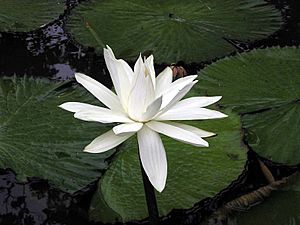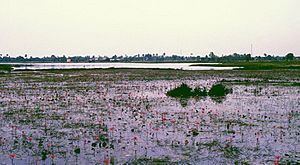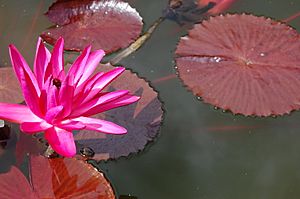Hairy water lily facts for kids
Quick facts for kids Nymphaea pubescens |
|
|---|---|
 |
|
| Hairy water lily (Nymphaea pubescens) | |
| Scientific classification | |
| Kingdom: | |
| (unranked): | |
| Order: | |
| Family: | |
| Genus: | |
| Binomial name | |
| Nymphaea pubescens |
|
The hairy water lily (scientific name: Nymphaea pubescens) is a beautiful type of water lily. It's also sometimes called the pink water-lily. This plant is famous for its pretty flowers and unique leaves.
Contents
Where Does the Hairy Water Lily Grow?
Its Natural Home
This plant is very common in shallow lakes and ponds. You can find it across many parts of Asia, both in warm (tropical) and milder (temperate) areas.
It grows naturally in countries like Bangladesh, India, Sri Lanka, Yunnan (China), Taiwan, Philippines, Cambodia, Laos, Myanmar, Thailand, and Vietnam. You can also find it in Indonesia and Malaysia.
Beyond Asia, the hairy water lily is also found in northeastern Australia and Papua New Guinea.
Where It Likes to Live
The hairy water lily grows both in the wild and in gardens or ponds where people plant it. It prefers water that is not too acidic. It also needs warm temperatures, as it doesn't do well if the water gets colder than 15 °C (about 59 °F).
What Does the Hairy Water Lily Look Like?
Roots and Stems
The hairy water lily is an aquatic plant, meaning it lives in water. It has thick underground stems called rhizomes or rootstocks. These rhizomes help anchor the plant firmly to the mud at the bottom of ponds or lakes.
From these rhizomes, slender stolons grow. These are like runners that help the plant spread.
Amazing Leaves
The leaves of the hairy water lily are quite special. The parts of the leaves that float on the water are round. The parts below the water are shaped like a heart. These leaves can be quite large, from 15 to 26 centimeters (about 6 to 10 inches) wide, and sometimes even up to 50 centimeters (20 inches).
The underside of the leaves is covered in tiny hairs, which is why it's called the "hairy" water lily!
Some leaves stand up slightly above the water, similar to how sacred lotus leaves look. However, most of its leaves simply float on the surface. The edges of the floating leaves are wavy, giving them a pretty, scalloped look.
Beautiful Flowers
The flowers of the hairy water lily are quite big and impressive. When fully open, they can be about 15 centimeters (6 inches) across.
Interestingly, these flowers tend to close up during the day and open wide at night. Their color can vary a lot. You might see them in white, pink, mauve, or even purple. The exact color depends on the specific type or hybrid of the plant.
Hairy Water Lily as an Aquarium Plant
This water lily is also sold for aquariums. People who keep fish tanks (called aquarists) like the attractive look of its underwater leaves. They often remove the floating leaves to keep it as a plant that stays completely underwater.
Naming the Hairy Water Lily
Why is it Called "Hairy"?
The scientific name "pubescens" means "hairy" in Latin. This name comes from the fuzzy or hairy undersides of the leaves and the stems, which are also covered in these hairs. You usually can't see these hairs when you look at the plant from above the water.
Different Names and Types
In different languages, the hairy water lily has other names. For example, it's called Shapla in Bengali, Kokaa in Hindi, and Kumuda in Sanskrit.
This species of water lily has many different types that have been grown by people. It also has many natural hybrids, which are mixes of different types.
One common name for a reddish type of hairy water lily is Nymphaea rubra. This variant is often sold as the Red water lily and sometimes has purplish leaves too.
See also
 In Spanish: Shapla para niños
In Spanish: Shapla para niños



